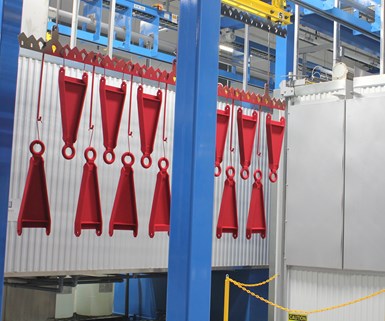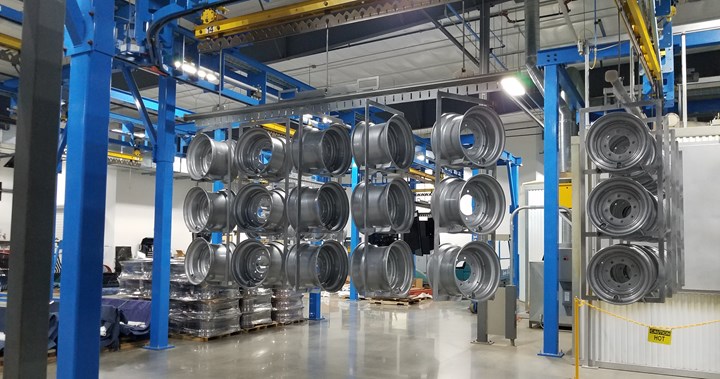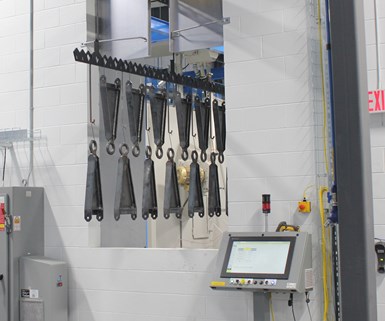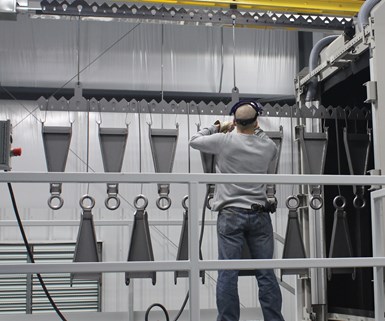Finding the right solution for a company’s finishing operations can be complex, especially when the needs are very custom. That was the case with JR Custom Metal Products (JRCMP), a Wichita, Kansas-based metal fabricator.
Several objectives were driving JRCMP’s need for a new powder coat solution:
Featured Content
- It was looking to increase the quality of the paint finish for its customers.
- Its existing process was outsourced and gave the company no control over quality and often required considerable rework. Further, outsourcing was proving to be extremely costly, coming in at over $1 million a year with slow lead times that were impacting operations.
- Dealing with a great variety in part sizes, JRCMP also wanted to be able to deliver the highest quality coatings based on its own values and to better meet customer turn times.

After masking, parts continue onto the powder paint booth where two painters apply powder coat.
With no control over quality or delivery timing, it was time to bring operations back in-house and build a system customized to its unique needs that allowed for more cost-effective processing.
“Once we made the decision to build a powder coat finishing line, we wanted to do it right,” says Jorge Martinez, vice president of sales and marketing at JRCMP.
Doing it right involved a lot of research and time to find a seamless solution to the challenges JRCMP was facing. It required a very customized solution for powder coating because of different part sizes, thicknesses and process times. It also needed to have the ability to stop for manual processes at the shot-blast, blow-off platform, dewatering station and a masking area, and for the powder coating application — all while minimizing any quality defects that could occur with operators stopping the conveyor or extending manual process times. Further, it required an optional path to an automated inline blast system.
Flexibility in the Job Shop

Once coated, the load bar releases the parts to the dual lane oven for curing, boasting 6-inch insulated walls to eliminate unnecessary heat loss.
“We are a job shop and we needed a lot of flexibility,” Martinez says. “We also wanted to blast on the line, not offline. Manually blasting a heavy 10-foot-long part or multiple smaller parts can take 20-30 minutes each, but with our system, we can blast 10 feet of loaded parts in as little as 30 seconds up to two minutes, depending on the part thickness and intricacy.”
After a four-year process of investigation, talking with a variety of vendors and visiting numerous sites with systems in place, JRCMP first chose Midwest Finishing Systems (MFS) to build its system. But, as its needs were explored, MFS decided to bring in IntelliFinishing, a Kansas-based finishing system builder that JRCMP was particularly intrigued with, especially its conveyor system.
“We use load bars that can hold up to 2,000 lbs. each,” Martinez says. “We can select dual lanes and have multiple substrates running all at one time because we can select a recipe for each particular load bar and not for the whole line. There’s not very many systems in the finishing industry that can do this.”

Having two lanes allows faster curing parts to move past slower curing parts, thus maintaining a higher level of throughput than traditional systems.
To meet all of JRCMP’s requirements, IntelliFinishing created a powder coating system where parts are loaded onto the carrier via load bars custom designed by JRCMP and the operator selects the paint process recipe for that particular batch of parts.
The ability to define, edit and store recipes is a huge milestone for the process, says John Claman, an IntelliFinishing sales representative and marketing supervisor. It determines exactly how parts will flow through the system.
“With a recipe-based system, each part or set of parts can receive a custom process,” Claman says.
Automated Shot Blast, Part Washer

IntelliFinishing customized the space between the oven and the unload station so that the parts have a sufficient amount of time to cool down before operator handling.
Once the recipe is entered, the parts either go to an automated shot blast for cleaning or move straight to the automated part washer. If it runs through the shot blaster, it does so at the speed defined by the recipe. Heavy parts may move through the blast at 5 feet per minute (fpm), while Claman says lightweight parts can be sped up to help minimize the profile at faster speeds, such as 10, 15 or even 20 fpm. For especially difficult parts, a recipe option can include backing the carrier up to blast the items twice.
Items then move into the automated wash that includes three stages and a dual halo final rinse of either reverse osmosis water or a sealer coat. After washing and blasting, the parts stop at the blow-off platform to remove any remaining water before entering a highly efficient dry-off oven. In the dry-off oven, parts are heated to evaporate any water residue before powder coating. Items may have different dry-off times based on substrate and complexity, ranging from just a few minutes to 20 or even 30 minutes. From the oven, parts are directed to a temperature- and humidity-controlled environmental room.

JRCMP is experiencing optimized operations and agile processing, Martinez says, and bringing the process back inside has increased part control for the company, improved quality, decreased costs and accelerated customer delivery timelines.
Next up is the masking platform. This station features a human machine interface (HMI) terminal that can access specific masking instructions based on the parts arriving at the platform. As with all of the HMIs, Martinez says operators can also see the entire system overview and have the ability to drill into any carrier to determine present status, recipe selections and order/part data.
“It is a smart system. We may have 10 different customers we are running on that shift and they are all intermixed — different sizes and substrates — and it doesn’t matter,” Martinez says. “Everyone tends to base things on line speed, but our system is really based on the recipe for that one load bar.”
The operator masks each part, then the parts continue on to the powder paint booth where two painters apply powder paint. Once completed, the load bar releases the parts to the dual lane oven for curing, which boasts 6-inch insulated walls to eliminate unnecessary heat loss. Claman says having two lanes allows faster curing parts to move past slower curing parts, thus maintaining a higher level of throughput than traditional systems.
Customized Space For Cooldown

JRCMP’s new system provides optimized flexibility in both part disparity and process customization.
After curing, parts proceed down the conveyor to the unload station where they are unloaded for packaging and shipping. In this final step, IntelliFinishing customized the space between the oven and the unload station so that the parts have a sufficient amount of time to cool down before operator handling.
JRCMP is experiencing optimized operations and agile processing, Martinez says, and bringing the process back inside has increased part control for the company, improved quality, decreased costs and accelerated customer delivery timelines.
JRCMP’s new system provides optimized flexibility in both part disparity and process customization. Further, for each load bar recipe process, data is collected and stored. From varying speeds through a process or parts moved quickly through areas where no processing is required, Martinez says having access to each unique recipe improves quality, consistency and throughput for similar parts that require analogous processing in the future. In addition, JRCMP users can easily manage the conveyor, equipment, processes and recipes from three HMI terminals.
Visit jrcmp.com, intellifinishing.com and midwestfinishing.com. Information provided by IntelliFinishing.
RELATED CONTENT
-
Masking for Surface Finishing
Masking is employed in most any metal finishing operation where only a specifically defined area of the surface of a part must be exposed to a process. Conversely, masking may be employed on a surface where treatment is either not required or must be avoided. This article covers the many aspects of masking for metal finishing, including applications, methods and the various types of masking employed.
-
Preparation of Stainless Steel for Powder Coating
Should type 316 stainless steel castings be sandblasted before powder coating, or can they be chemically etched? Should the parts be pre-heated in an oven before coating?
-
Developments and Trends in Powder Coating
New solutions for powder coating centers combine powder preparation, conveyance, dosing and color changes into a fully automated, closed system.




















